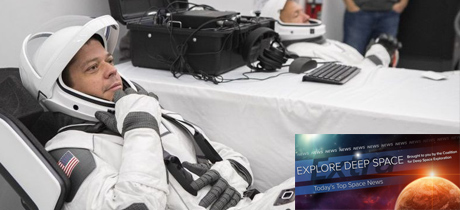In Today’s Deep Space Extra… NASA astronauts don corporate space suits. European/Russian Mars lander missions hits a parachute snag. Mission teams are to survey four possible landing sites for NASA’s Osiris-Rex sample return mission at the primitive asteroid Bennu.
Human Space Exploration
Astronauts test out their sleek new SpaceX flight suits
Smithsonian magazine (8/12): NASA astronauts Bob Behnken and Doug Hurley recently donned new SpaceX space suits at company facilities in Hawthorne, California, as they continue preparations for the Demo-2 mission, the first round trip test flight of the Crew Dragon capsule to the International Space Station (ISS) with astronauts aboard. The look of the garments comes from Hollywood costume designer Jose Fernandez.
Nuclear reactor for Mars outpost could be ready to fly by 2022
Space.com (8/12): NASA, perhaps by 2022, is moving closer to developing a small nuclear reactor for use as a spacecraft propulsion source as well as for planetary surface electricity generation for the human exploration of the Moon and Mars. The 2022 estimate follows crucial ground testing in late November 2017 and early 2018 in cooperation with the Department of Energy.
Space Science
Europe and Russia’s mission to Mars runs into a speed bump after two failed parachute tests
The Verge (8/12): An August 5 European Space Agency (ESA) test of the parachute system that is to land the ExoMars 2020 mission on the surface of the red planet in 2021 failed. The test was conducted with a drop from a high altitude balloon over northern Sweden. The primary parachute in the test exhibited damage to the canopy prior to inflation. The damage was similar to the outcome of a test in May. ExoMars 2020 is a joint European Russian mission to Mars with a lander and rover planned for launch in July/August 2020 and arrival at Mars in March 2021.
Robonaut to return to ISS
SpaceNews.com (8/12): NASA’s experimental humanoid, Robotnaut 2 (R2), arrived at the International Space Station (ISS) in 2011 as a space shuttle payload to demonstrate some astronaut capabilities, especially when it came to working with its hands and performing some maintenance duties. Electrical issues, however, prompted R2’s return to Earth in May 2018. Now, engineers are working to return R2 back to the space station late this year. A humanoid like R2 might be able to assist on future spacewalks and play a role in NASA’s plans to establish a sustainable human presence on the Moon in the coming decade.
A monster black hole has been found with 40 billion times the mass of the sun
Universe Today (8/10): Just 700 million light years away and sitting in the galaxy Holmberg 15A is a super massive black hole estimated to be 40 billion times more massive than the sun. And that refines an estimate that was once much more massive. Nonetheless, it’s not the most massive super massive black hole ever discovered. Astronomers carried out the work with a ground based observatory in Chile.
NASA mission selects final four site candidates for asteroid sample return
NASA (8/12): NASA’s Osiris Rex asteroid sample return mission team will study four potential landing sites at the spacecraft’s distant target destination, the primitive asteroid Bennu, the space agency announced Monday. Launched in September 2016, Osiris Rex reached Bennu in June 2018 only to find the surface was much more boulder strewn than assumed. Mission managers have decided to spend four extra months studying four sites with potentially sufficient clearance from large rocks before down selecting to primary and secondary landing sites in December to receive additional low altitude reconnaissance. Sufficient clearance from large rocks is required so that Osiris Rex can touchdown briefly in late 2020 to collect surface material from Bennu for return to Earth on September 24, 2023. Scientists expect to learn more about how the solar system’s planets formed, obtained their water and organics, the building blocks of life.
Other News
A twenty-first-century Sputnik moment: China’s Mozi satellite
Nippon.com (8/13): Mozi, a Chinese satellite launched in August 2016, may have been the equivalent of a modern Sputnik moment, according to an expert in space and international law. Mozi introduced an advanced technology, quantum communications to space for the first time, an advantage in relaying secret military and diplomatic communications, according to her assessment.

